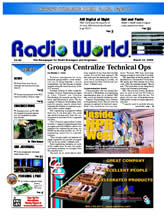
 |
|
|||||||||
|
|
 |
||||||||
 |
AM NRSC Measurements by Mark Persons W0MH |
Radio World Article April 7, 2003 |
|
Occupied
bandwidth and RF harmonic measurements are required on all AM stations annually.
The FCC allows a maximum of 14 months between successful measurements to
stay in compliance. This kind of
measurement, otherwise known as NRSC, replaced annual "Audio Proof of
Performance" measurements and was required starting on June 30, 1994.
The
first year saw many stations making equipment changes to bring facilities into
compliance. As a result,
interference on the AM broadcast band has noticeably decreased.
Details
for Engineers:
AM
NRSC compliance testing kept a lot of other people, including me, busy these
days. As a C-QUAM AM Stereo
installer and technical consultant to 40 stations, I was well aware of the
problems stations could face in getting transmitters to pass the occupied
bandwidth and spurious emission tests.
A
legal loophole was inserted in the FCC rules in 1990 when the FCC temporarily
suspended the requirement to do performance testing if the stations involved had
installed an NRSC compliant audio lowpass filter.
AM
RF harmonics are required to be suppressed at least 73 DB below carrier on a
Of
the 47 stations I personally measured the first year of NRSC, about 20% did not
make specifications on the first try. About half of those had RF harmonic levels in excess of that
allowed by the FCC. The other half
had occupied bandwidth problems.
I
found two stations with significant RF mixing products resulting from proximity
to another AM station. Both of the
troubled stations had Harris MW-1A transmitters although the problem can happen
with any transmitter. It is just a
matter of degree. For one station,
I built and installed an RF trap to keep the unwanted station from getting into
the transmitter. The trap lowered
the level of the unwanted station until the mixing product was transmitted at a
level that was low enough to make FCC specifications. In the other case, the two stations involved were 60 KHz
apart. The mixing product appeared
60 KHz on the other side of the client's carrier at about 68 DB down.
It fell within the NRSC mask. If
it had not, the mix would have been illegal.
So, the client was lucky in that he did not need to purchase an RF filter
even though the mix was 5 DB hotter than would otherwise be allowed.
I
have carried a Delta Splatter Monitor since they were first introduced.
It makes a great precision demodulator for tuning AM transmitters.
For occupied bandwidth measurements, I carry a spectrum analyzer.
It has an RS-232, which links to a notebook computer.
The screen data is stored on floppy disk, which is carried back to the
office and printed by a desktop computer along with the rest of the report.
If
a transmitter sounds good on the air then chances are it will pass the occupied
bandwidth testing. I ran into a few
stations where the processing badly smashed the audio before the NRSC low pass
filter. The station sounded
bad, but passed the test.
Tube
type transmitters are most likely to have bandwidth problems when the tubes have
low emission. Almost no tuning will
fix that. Remember that harmonic
products of audio may easily fall outside the 10 KHz bandpass if the harmonic
distortion is created in the transmitter after the NRSC filter.
I
ran into several pulse duration modulated transmitters with problems.
One was a Continental Power Rock where a PDM filter coil went out of
tolerance allowing more than the legal amount of 70KHz modulator switching
frequency through. A Nautel AMPFET
5 had an open capacitor in one of its 70 KHz notch filters.
It
seems all of the Harris MW-1 and 1A transmitters I checked used up more of the
dial than their high level plate modulated counterparts.
In most cases, adjusting the RF Driver tuning made a big change in how
clean the transmitter was. Harris
recommends running the RF driver at about 1.5 ampere of DC current. They also
have a modification kit to clean up much of the splatter.
Apparently transmitters on the high end of the AM band are most likely to
occupy more bandwidth than is allowed. The
kit takes at least three hours to install.
See you further down the road.
I'll leave the soldering iron on for you.
Mark Persons, W0MH, is certified by the Society of Broadcast Engineers as a Professional Broadcast Engineer with more than 30 years experience. He has written numerous articles for Radio World over the years. His Web site is www.mwpersons.com From the Radio World April 7, 2003 issue http://www.rwonline.com
|
|
Questions? Email Mark Persons: teki@mwpersons.com |
|